Here’s everything you need to know to start creating effective lead magnets, together with seventeen inspiring examples.
Six things make lead magnets effective:
- Helpful and actionable. Address a specific problem that your target audience is facing and provide a practical solution that’s within their reach.
- Compelling. Offer something unique and irresistible.
- Instantly accessible. Your leads should be able to access your resource immediately.
- High-quality. Your resource may be one of the first contacts with your brand - make a good impression.
- Relevant to your product or service. This ensures you will get a more qualified audience and possibly higher conversion rates.
- Clear conversion path. Typically a lead magnet consists of a landing page with the sign-up form, a thank you page with access to the free resource, and a follow-up message (or a sequence of messages).
Learn the most popular (and most effective) ways to capture leads.
1. Free tools
This type of magnet involves creating and offering a tool or service to potential customers at no charge.
Everyone expects to get something for free on the internet these days. And a lot of companies have been leveraging that expectation to get prospects closer to their brand.
It makes perfect sense when you think about it. If you want people to experience your product and you spend hefty sums to get them to visit your website, why “spoil” everything with any kind of friction?
To reduce friction, you can distribute samples of your product’s functionality as free tools. An example of such a scenario is our very own Ahrefs, the all-in-one SEO toolkit. We offer visitors to sign up for the free Ahrefs Webmaster Tools if they’re not ready to get the full deal.

Why it works:
- Attracts visitors by offering to solve a problem for free while increasing your brand awareness.
- Allows you to show a sneak peek of your product and offer an upgrade.
- Puts the lead on a nurturing program.
- Decreases friction to your product.
2. Product trials and samples
This type of lead magnet allows users to try a product or service risk-free. Since users usually need to fill in their contact information to get access, you can use that information to get in touch with them.
You can limit your free trial by making it accessible for a set time and/or introducing certain features.
Here, we’ve got examples from two competitors that provide book summary services. Blinkist lets you try its entire product for free for a limited time.
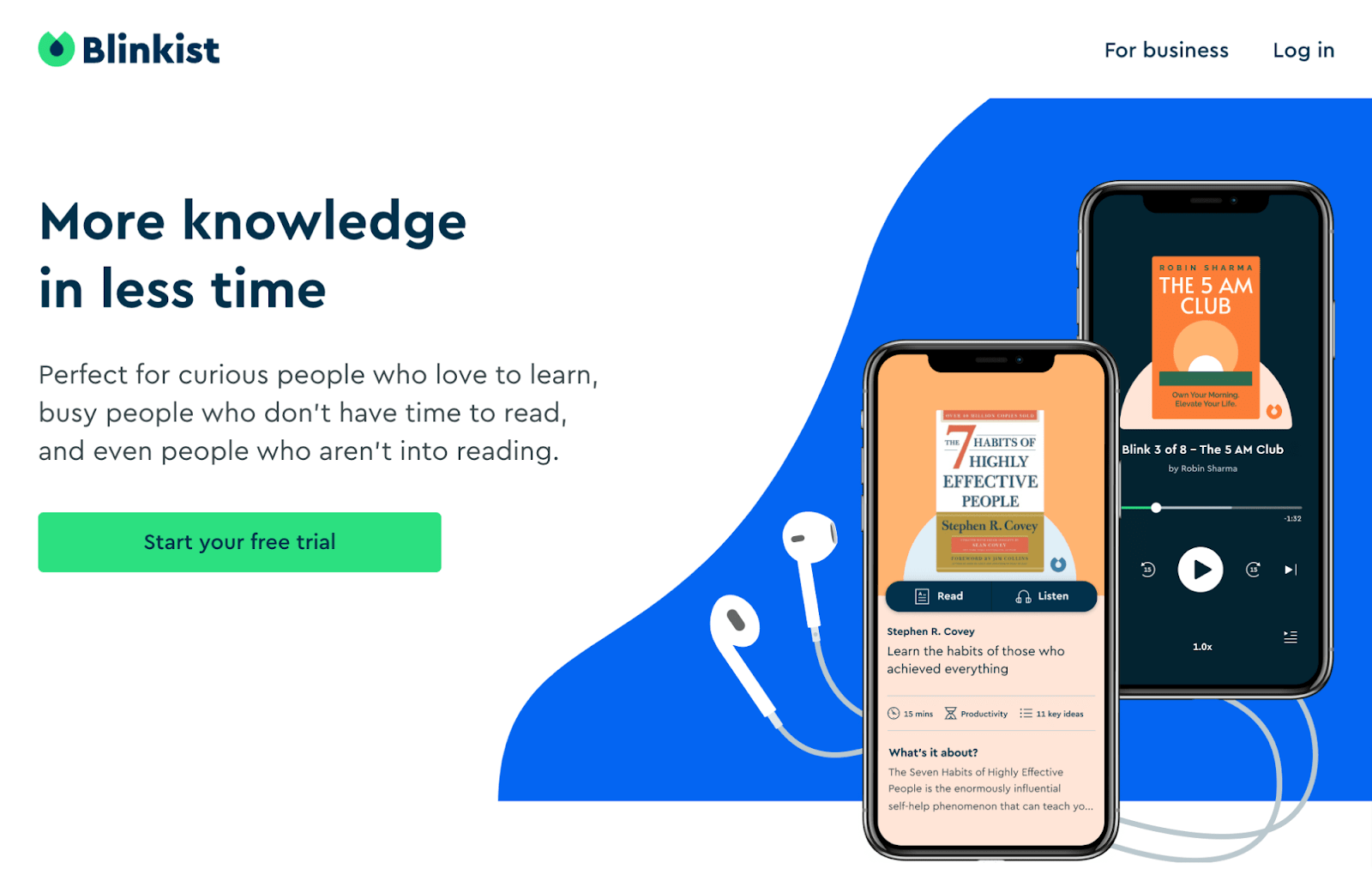
A cool takeaway from this example is how it surveys visitors before it lets them in. I mean, why wouldn’t someone “invest” one minute or even less to fill the survey and get something for free?
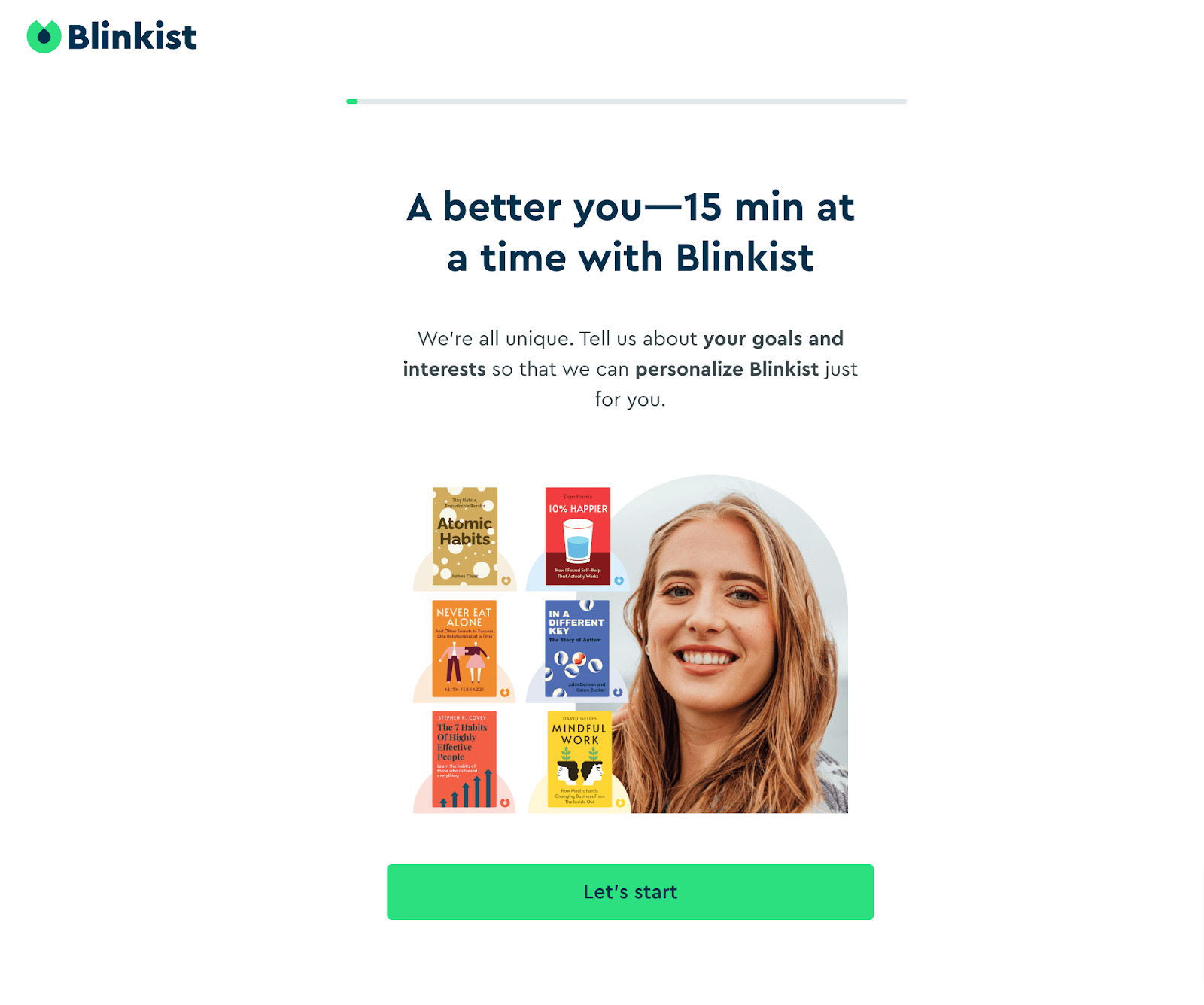
And below, we have its competitor, Soundview. You can’t get a trial period here. Only a sample of a book summary. Makes sense because one book summary should be enough to get a feel of the quality of Soundview’s product.

Why it works:
- The user can try your product before they buy it.
- While the user signs up for a free trial, you can offer them to sign up for a newsletter (or some kind of lead nurturing flow).
- The friction to your product is decreased.
- You can survey users during the onboarding to get market research data.
3. Early access/waiting lists
An early access/waiting list is a type of lead magnet where you collect contact information in exchange for accessing your product before everyone else.
This idea might be a good fit for you if:
- You’ve got a product idea that needs to see the light of day ASAP.
- You want to launch it to a limited number of people before going big.
- You want to get feedback from that small group of people before the entire internet sees it.
In this example, we’ve got Chip, the savings app. It launched its product with this kind of lead magnet. From the look of the website now, it must have worked out nicely for the company.

Why it works:
- You can build a list of potential customers even before launching your product.
- You can use your list to discuss product functionality. Early birds are often the savvy people within your niche.
- It allows you to ship fast to a small/controlled group.
4. Discounts and bonuses
In this type of lead magnet, you offer visitors a discount or a bonus as an incentive to leave their contact information.
It’s a great idea for solving two challenges at the same time: giving people a nudge to shop for your brand and getting a direct marketing channel to people interested in what you offer.
Quiksilver, the clothing brand, offers free shipping and free returns when people sign up for a free account. And it’s probably a win-win. I’m sure that free shipping and returns cost the company less than distributing its goods through other shops. Smart.
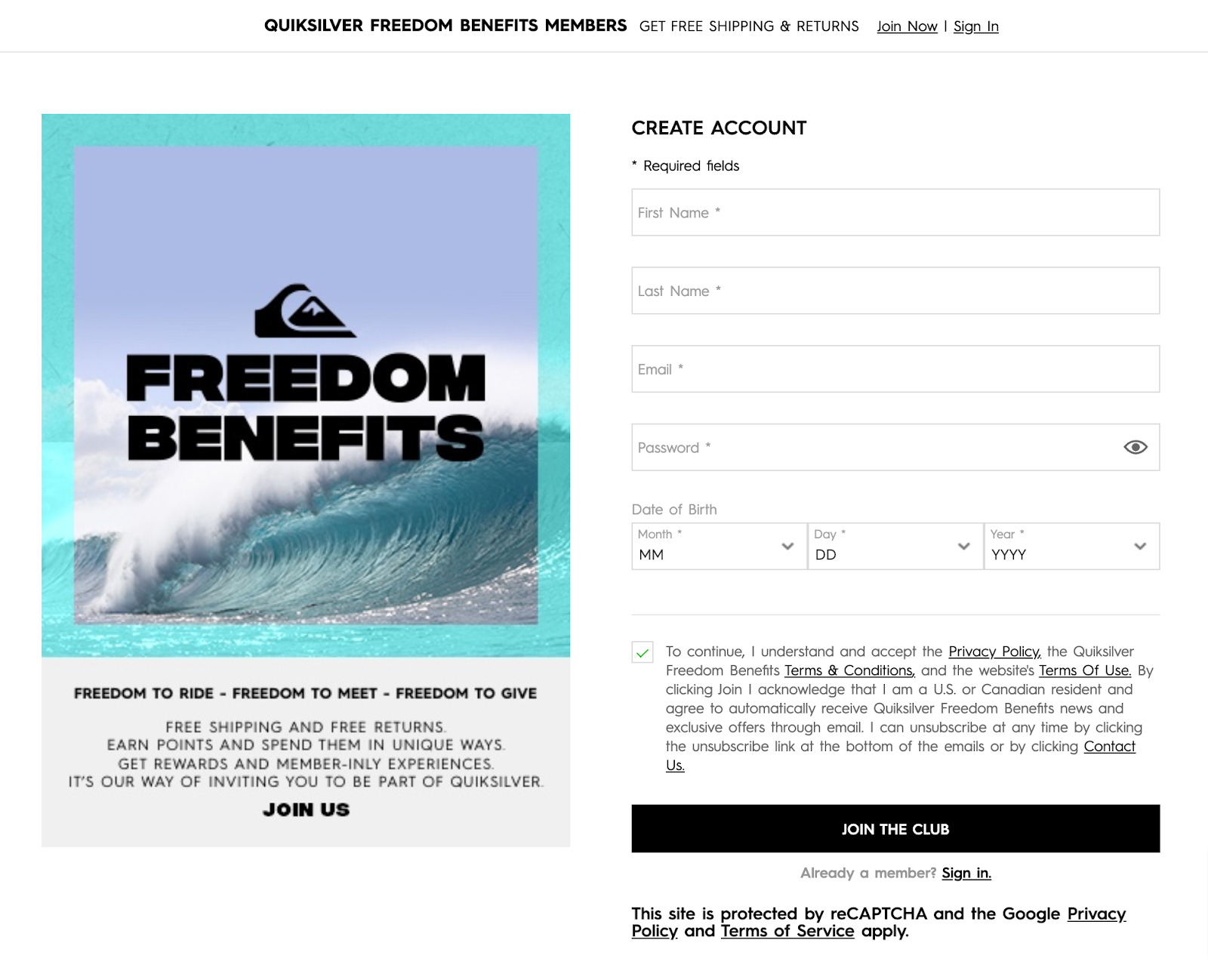
WAWWA, another clothing brand, offers 15% off the first order just to get your email address. I guess that tells a lot about the power of having a prospect’s email address.
I love how it promises you a lot of spam. Everybody promises not to spam, but this brand does the opposite. WAWWA will probably send you product deals, which you expect and is what the brand “warned” you about. Nobody can complain about that.
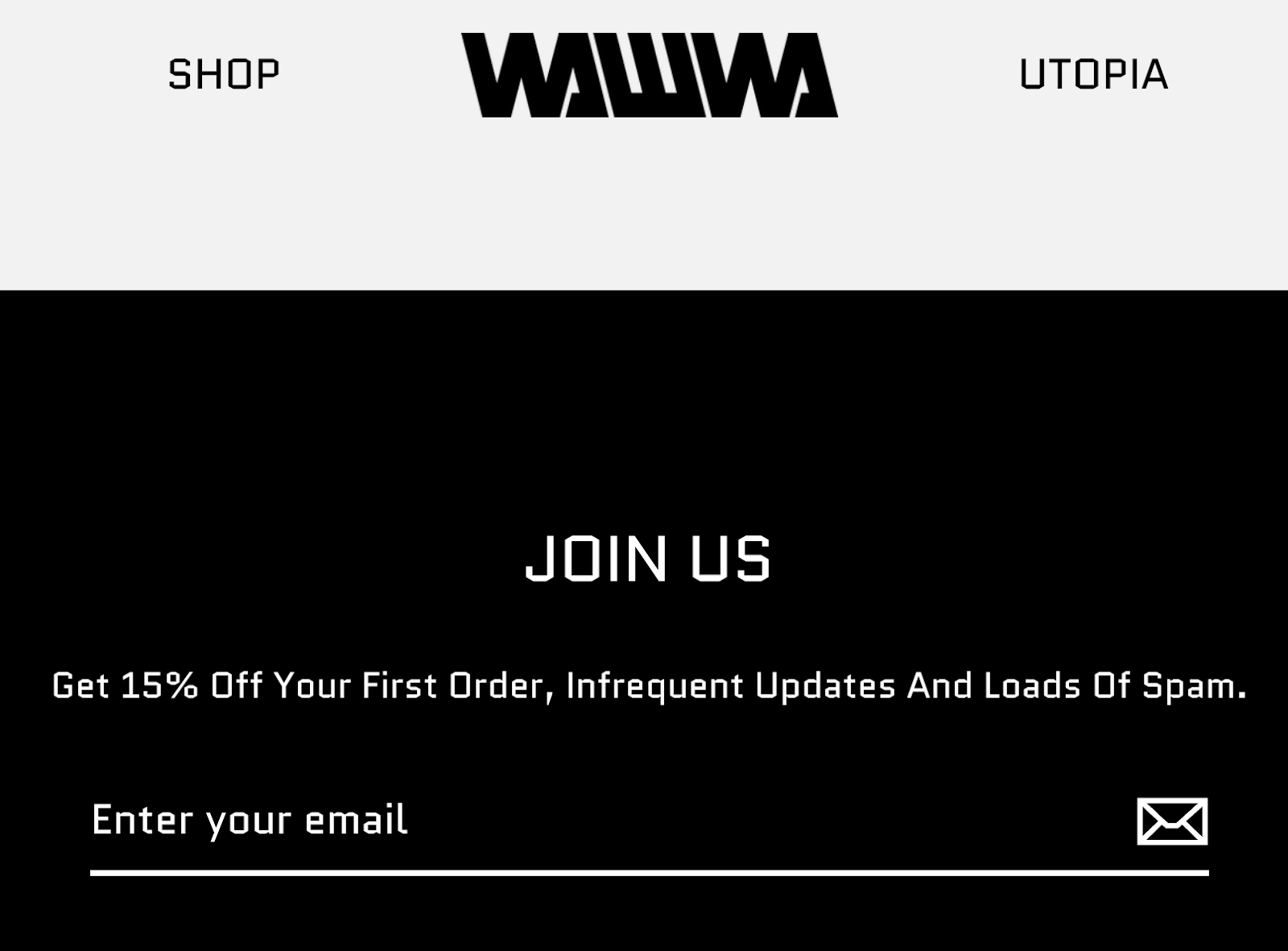
Why it works:
- People love discounts. Exchanging their email for a discount is quite a fair deal.
- Discounts can nudge your visitors toward making a purchase from you.
5. Product demos
This idea is about getting a prospect’s contact information while signing them up for a product demo. People interested in a product enough to devote their time to a product demo usually don’t mind sharing more than just their name and email.
Self-service product trials can be ineffective when you’re dealing with a complex product. In those cases, a prospect is better off with some guidance rather than presented with a mosaic of buttons and dials. This is where guided product demos come in.
Depending on your target audience and market, you can also try other sales materials like comparisons, fact sheets, or third-party reports on your product.
Help Scout has figured out the best way for a newcomer to experience its product (and convert into a happy customer) is to simply learn what the product is all about in a 1:1 demo.
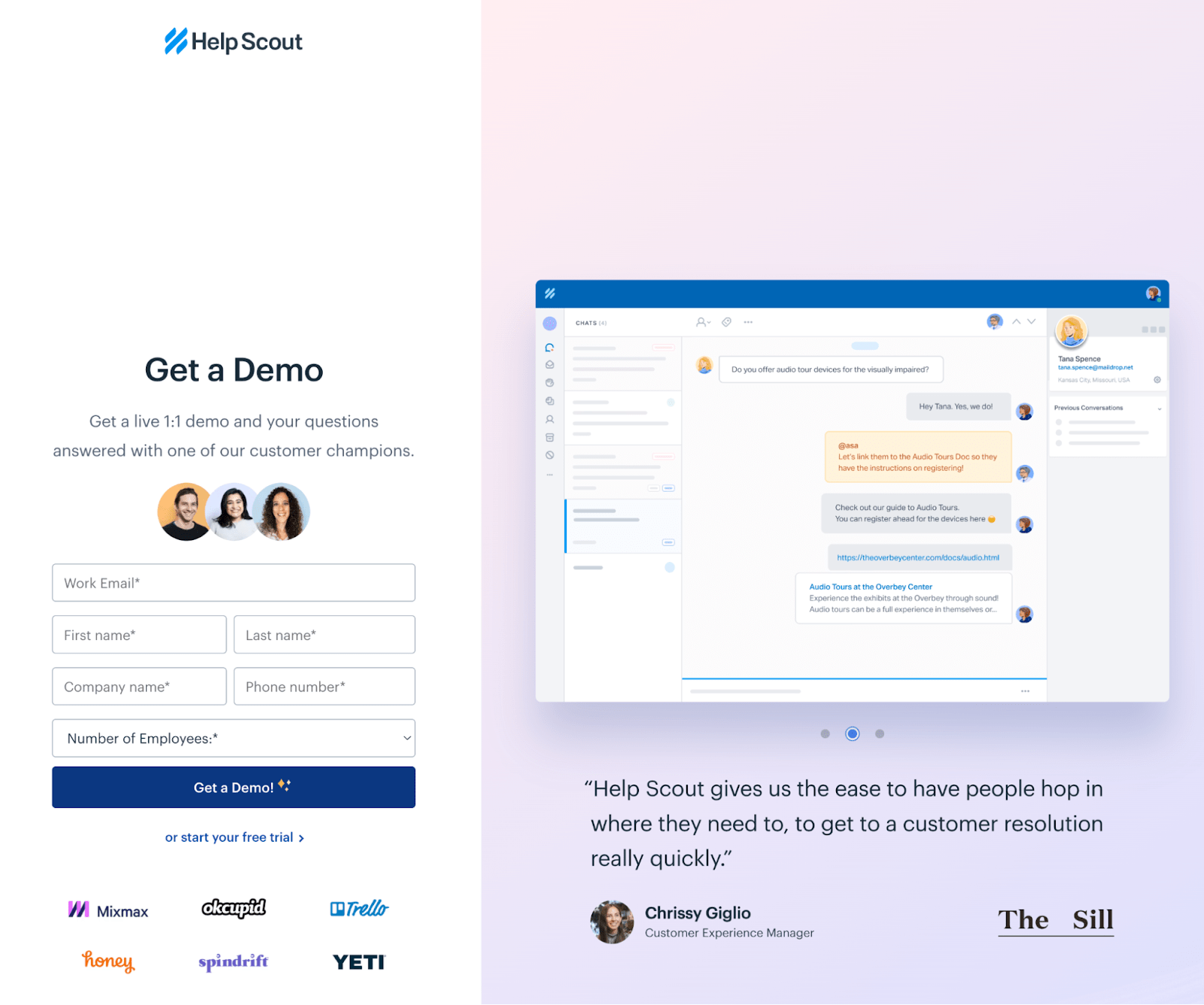
An interesting solution when it comes to demos is to have a chatbot prequalify the lead and schedule an appointment with them and your sales team. This example is from Metadata.io.

Why it works:
- People who sign up for product demos are usually considering the offer quite seriously.
- You can get in direct contact with the lead: answer questions, fight objections, or even show how your features shine.
- This is a subtle but effective solution if you’re not comfortable with sharing details about your product on the open internet.
- This is a common practice to attract enterprise customers, who usually have high requirements and specific needs.
6. Free consultation
Free consultation lead magnets gather contact information in exchange for some kind of service or for the ability to consult a subject matter expert at no cost. It’s an ideal solution for all kinds of agencies and service providers.
In this example, agency Single Grain offers a free, custom marketing plan. No better “foot in the door” for a marketing agency than this.
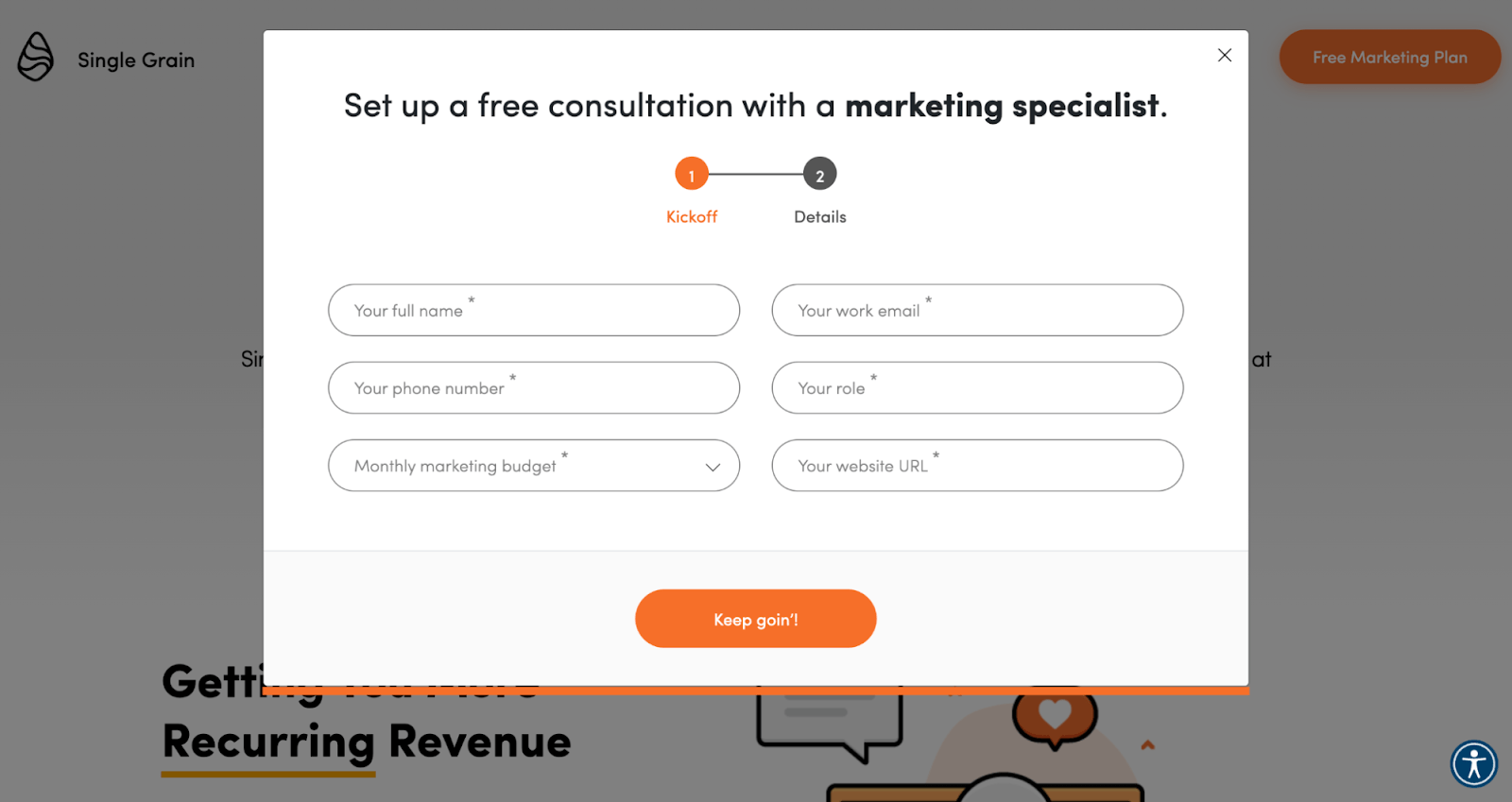
Why it works:
- Get in direct contact with your audience and personalize your message.
- Allows you to get your “foot in the door”.
- Potential to create the reciprocity effect.
7. Courses
This type of lead magnet requires creating premium educational material to turn your visitors into leads.
Since you’re giving out a lot here, you can ask for more in return. What’s more, education never ends for people serious about their profession so a quality free course can get you a “foot in the door” to offer paid courses.
Also, you don’t need to create a special course just for lead generation. You can use a part of your premium course or repurpose existing content.
This example from Qlik covers all bases about courses as lead magnets:
- Search queries related to data literacy lead to free courses on the platform.
- Free courses lead to assessments and paid courses.
- Assessments and paid courses lead to submitting contact information.
Reading the list from points #1 to #3 gives you the user’s perspective. Reading it from points #3 to #1 shows you the company’s perspective. I think Qlik discovered that the more people know about the role of data in business, the more customers it can have.
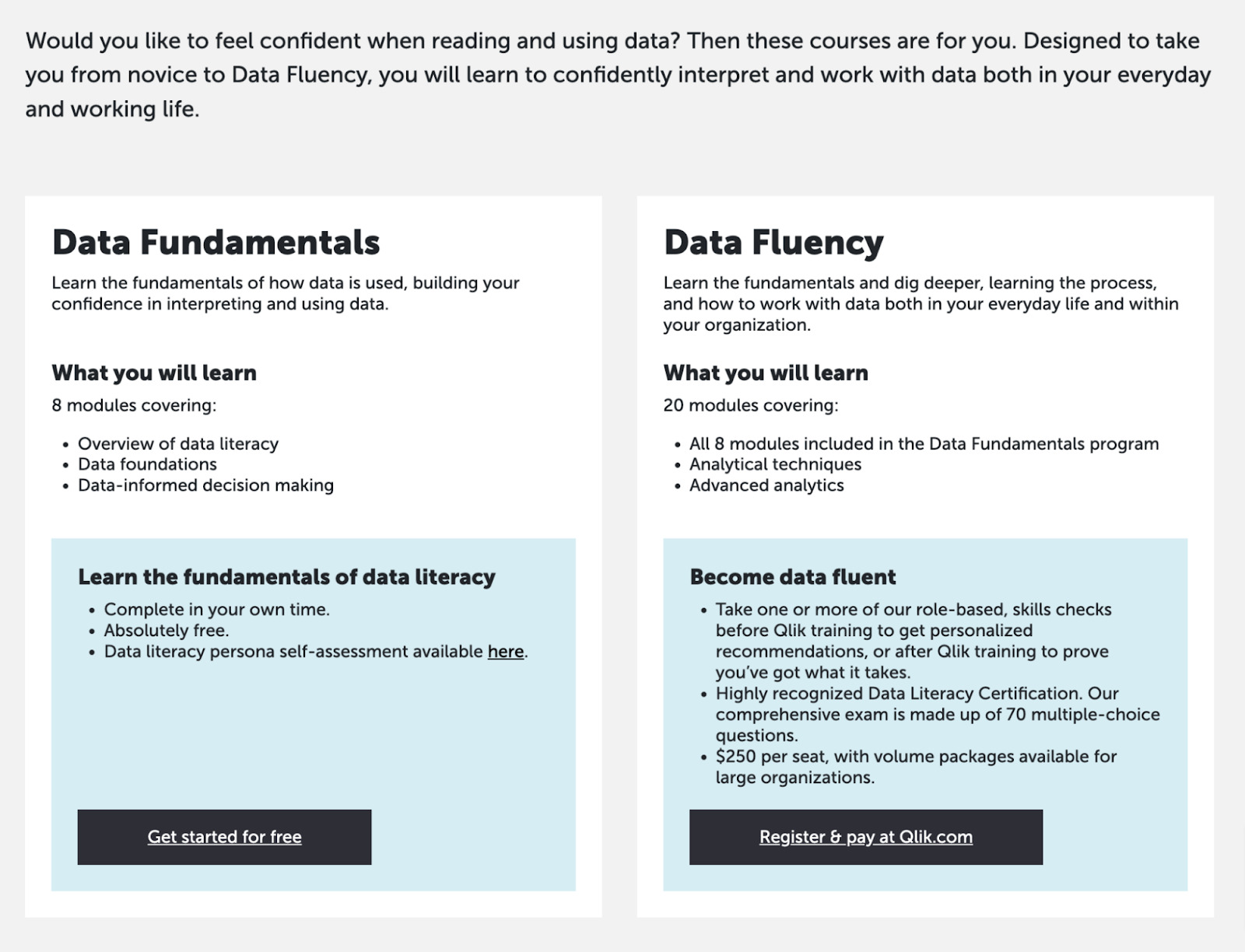
Why it works:
- Courses are considered premium assets.
- You can educate your audience over a longer period.
- Courses are a great source of organic traffic.
8. White papers
A white paper is a comprehensive report or guide that informs readers concisely about a complex issue or problem and presents the brand’s solution or viewpoint on it. It’s somewhere between a B2B sales pitch and an academic paper.
In this example, Ultimaker (a 3D printer manufacturer) gathers contact information from an audience interested in the real cost of owning a 3D printer. Naturally, one of its products is used as an example here.
I think it’s doing a good job because a) you read about its printer, but it doesn’t feel like product placement, and b) it’s true that other manufacturers don’t always communicate the full cost of owning a 3D printer.

Why it works:
- You can save your most in-depth, expert content for your most qualified audience.
- This is a good way to show your expertise.
- You can use this opportunity to customize your content for specific market segments.
9. Ebooks
Some problems are just too broad to tackle with one blog article. That’s where ebooks come in.
Ebooks are some of the most irresistible lead magnets because they offer free education on complex, professional topics that you’ll find hard to get anywhere else.
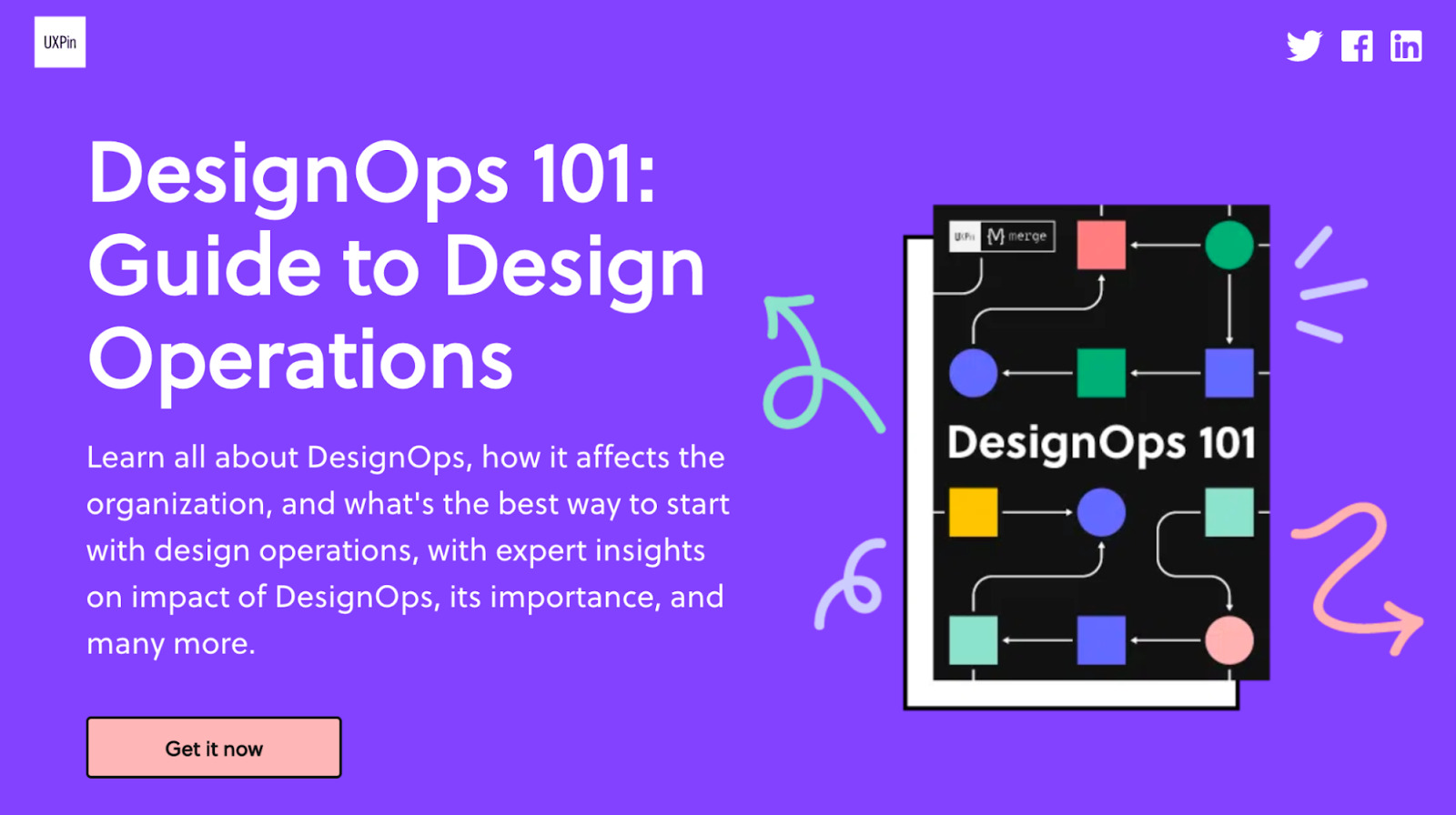
Why it works:
- Ebooks attract people who are interested in learning more about your niche. They are likely good candidates in lead nurturing campaigns.
- Ebooks are considered premium content.
- Ebooks can be a part of a larger content distribution program. They can even be made with repurposed content.
- This is a rare opportunity to get someone’s attention for more than five minutes.
10. Webinars/virtual summits
Both webinars and virtual summits are events hosted online but what sets them apart is size. Webinars are smaller and more focused, virtual summits aim to replicate in-person conferences.
There are several advantages of this type of lead magnet over those offering text-based content:
- Interaction between presenters and the audience.
- Visual and audio content can provide a more engaging learning experience.
- Experts draw audience attention and increase the credibility of content.

Why it works:
- Attracts industry professionals.
- Doesn’t always require you to create content—the speakers can do that.
- Brings invited guests, especially those who are influencers in your industry, closer to your brand.
- Live sessions let you communicate with audience.
- Can be recorded and used as evergreen content.
11. Reports
Reports are usually collated after hundreds of professionals are surveyed. These professionals are often, if not always, the issuer’s customers. Only then can the report be something truly new and unique. So this is not something every company can put together.
But when you do manage to put something like this together, it speaks volumes about the scale of your operation.
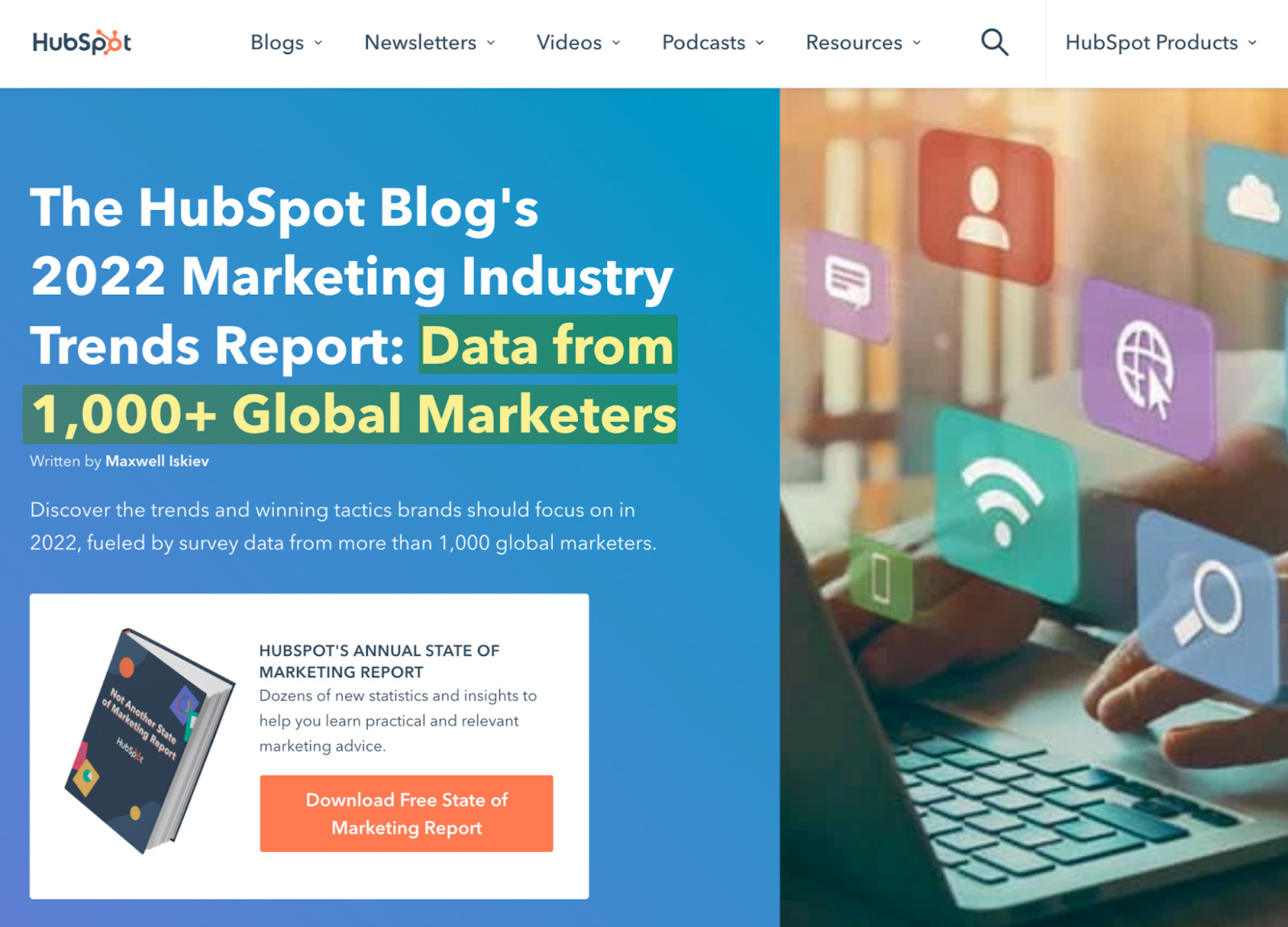
An additional bonus of getting leads is that reports tend to naturally earn backlinks, which is one of the most important success factors in SEO.
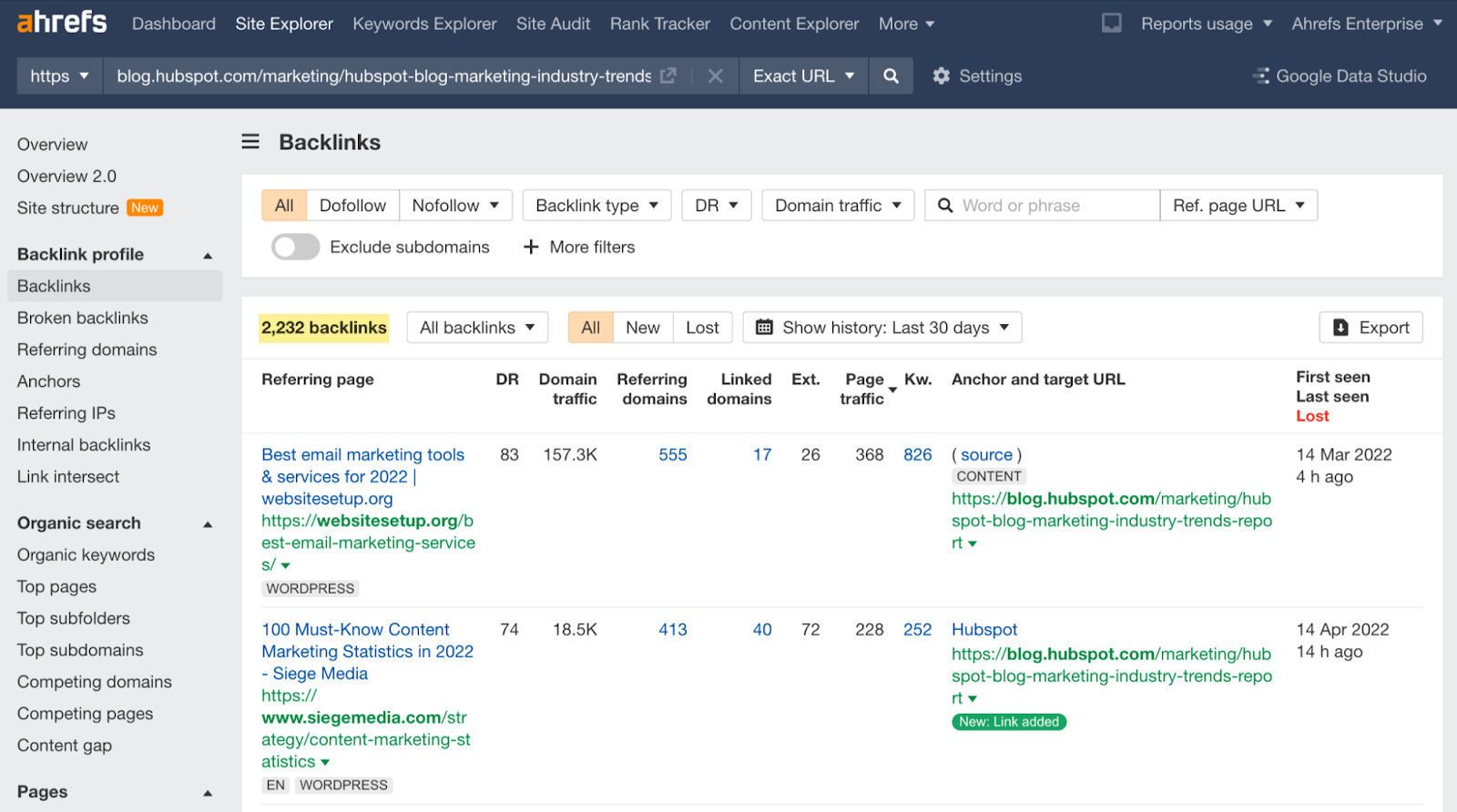
This one report earned Hubspot over 2k backlinks. Data via Ahrefs’ Site Explorer.
Why it works:
- Reports are considered premium content.
- Reports can be great linkbait.
- On top of acquiring leads, you can additionally gain brand awareness if your reports get cited online.
- Reports usually attract industry professionals. And press too.
12. Newsletters
This form of lead magnets doesn’t really need an introduction. You can find newsletter sign-up forms all over the web.
Some of those newsletters are just that—a content digest regularly delivered to one’s inbox.

And some are a gateway to a lead nurturing program. It’s common to see companies pitching their products or special deals in between the regular news.
Why it works:
- Great way to remain in regular contact with your audience.
- Allows you to distribute any kind of content, e.g., educational materials, discounts, special announcements, etc.
- Good entry point of marketing automation programs.
13. Calculators
This type of lead magnet utilizes calculators designed to solve specific problems: ROI calculators, financial calculators, statistical significance calculators, and so on.
They are a brilliant way to lure in B2B prospects because a lot of decisions in business need to add up. But they can also work for B2C, e.g., mortgage calculators.
A “lead magnet” calculator can be directly related to your product, but it doesn’t have to be. It can be about something that your audience cares about. A good example is this customer support hiring calculator from Help Scout:

Why it works:
- This helps to answer any customer’s fundamental questions, e.g., “Is it worth it?”
- It’s a good opportunity to pitch your product or service directly.
14. Cheat sheets and checklists
A checklist is a list of items or tasks that need to be completed, checked, or remembered. While a cheat sheet is a concise set of notes used for quick reference; all the essential information in one place.
Great if your prospects are involved in a lot of repetitive work professionally. They won’t have to look up the same small bits of information or remember all the details that can make or break a complex process.
No wonder developers love cheat sheets. Here’s an example collection of cheat sheets from Opensource.com. Each one is a lead magnet.
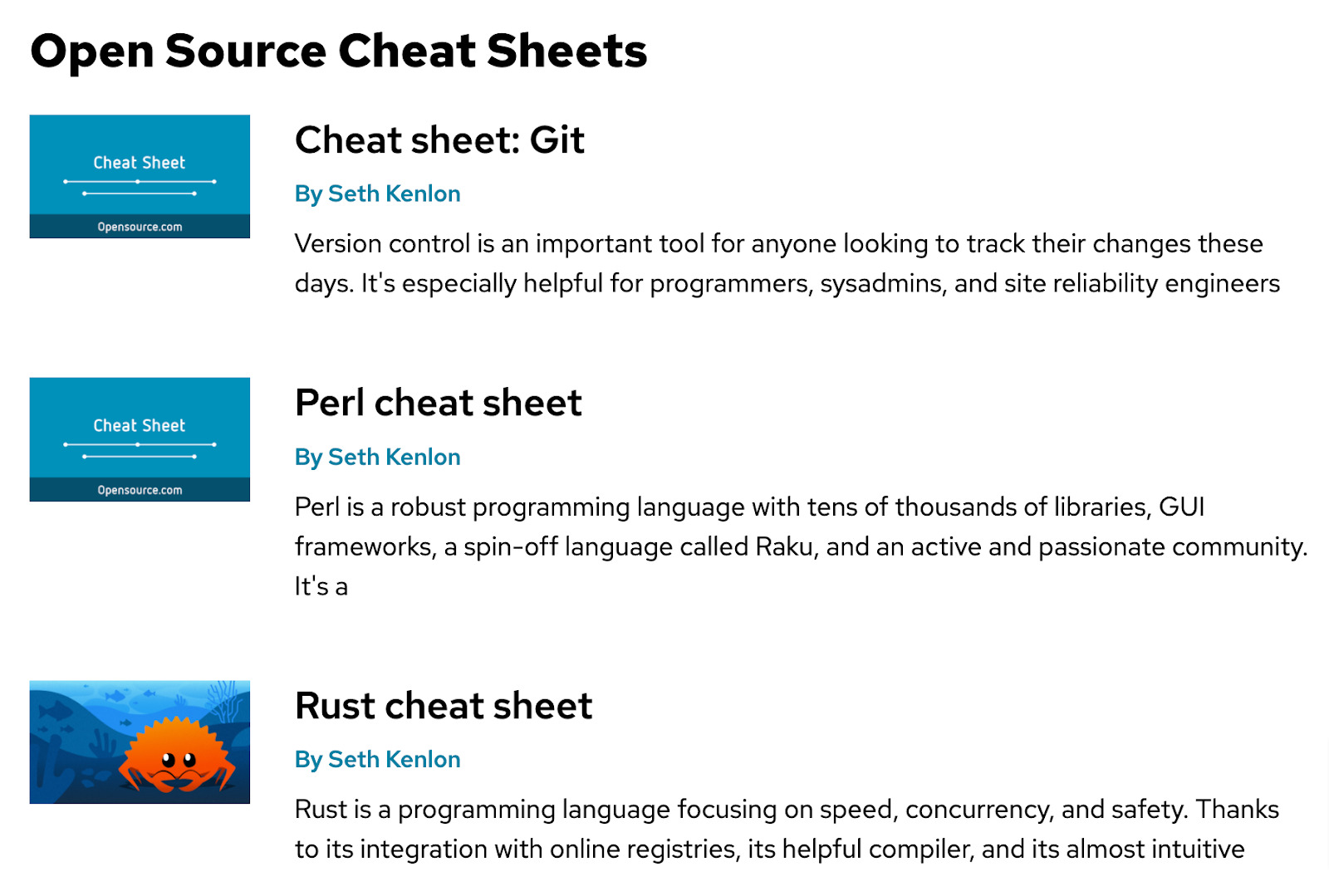
Here’s another example. Creating a press release can be stressful. You need to work with different stakeholders, get everything absolutely right, and sound interesting to the press at the same time. A “press release checklist” lead magnet is hard to resist.
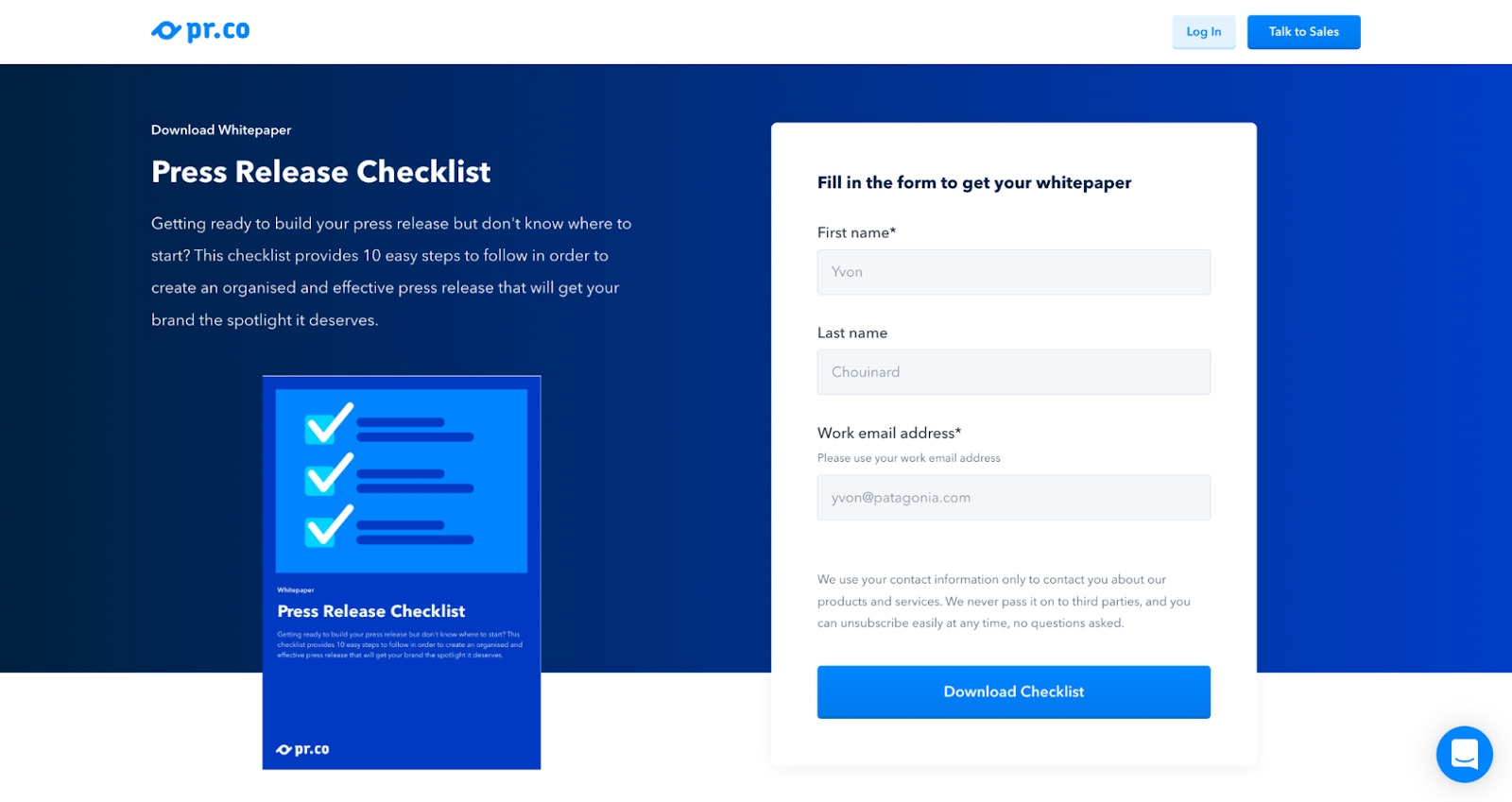
Why it works:
- Great way to attract an audience at the top of the funnel.
- Often shared.
- Likely to be used multiple times, equating to multiple opportunities for people to remember your brand.
- Highly practical: saves people time and unnecessary mistakes, offering positive emotional potential that can be associated with your brand.
15. Templates
Along with ebooks and newsletters, free templates are one of the most popular lead magnets.
A template is a pre-formatted file or document that serves as a starting point, eliminating the need to recreate everything from scratch. Your visitors will want to get it to save time, increase efficiency, and maybe even ensure consistency within their team.
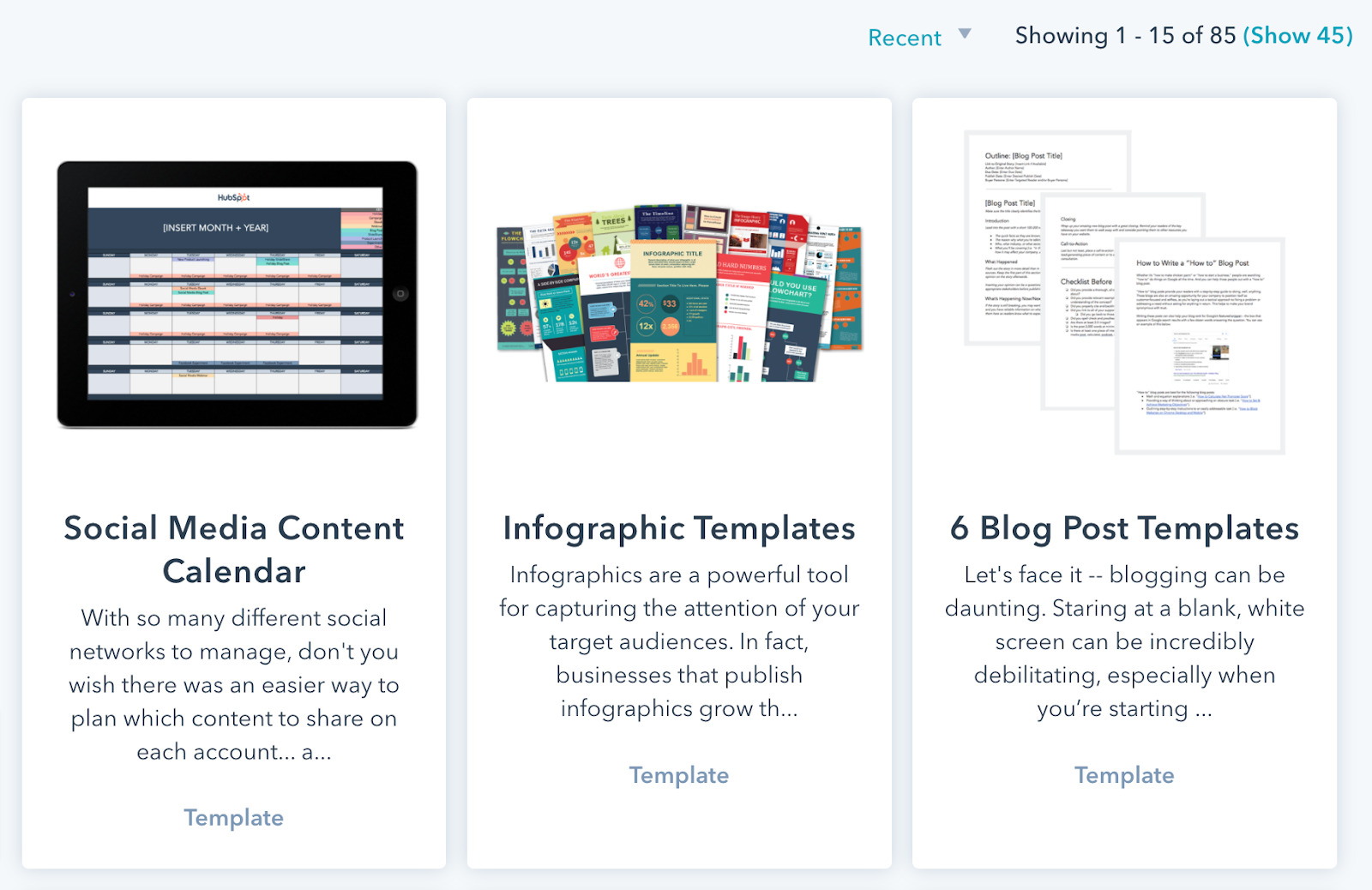
There’s nothing wrong with using a template at work. A lot of people do that. If they’re not using somebody else’s template, they’re using their own. Templates allow professionals to keep the quality of their work consistent without needing to go over the same problem multiple times.
Why it works:
- Templates are a practical tool likely used multiple times. This means multiple opportunities for brand exposure.
- Templates can be great linkbait.
- Adding a template to a blog article can increase your chances of ranking on search engines (if that aligns with the search intent of the query).
16. Swipe files
Looking for inspiration is probably one of the most common reasons to go online. And there’s a special lead magnet for that as well.
In case you haven’t heard about them, a swipe file is a place to store inspirational ideas, successful marketing materials, effective headlines, and more.
Here, we’ve got Webprofits’ swipe file of handpicked landing page examples from 73 high-growth companies.

Why it works:
- Great for helping people looking for inspiration.
- Allows the reader to save time on separating the wheat from the chaff, as swipe files are carefully curated ideas.
17. Contests, quizzes, and giveaways
To generate leads for your business you can also hold a contest, quiz, or giveaway.
This type of lead magnet can get you high volumes of leads but it’s a bit tricky to handle.
Getting a lead from a lead magnet that promises a prize is the easy part. The hard part is to convert that lead later on because you can attract leads not interested in your product (if the prize is something different from your product).
One way is to try and get their attention while they wait for the winner’s announcement. Another way is to point them to your product through a drip campaign after the whole event.
Here’s an interesting example. It combines a quiz and a contest. First, the visitor completes a personality quiz to reveal their perfect home decor style. Next, they can enter the contest to win furniture in that exact style. You can read the full case study here.
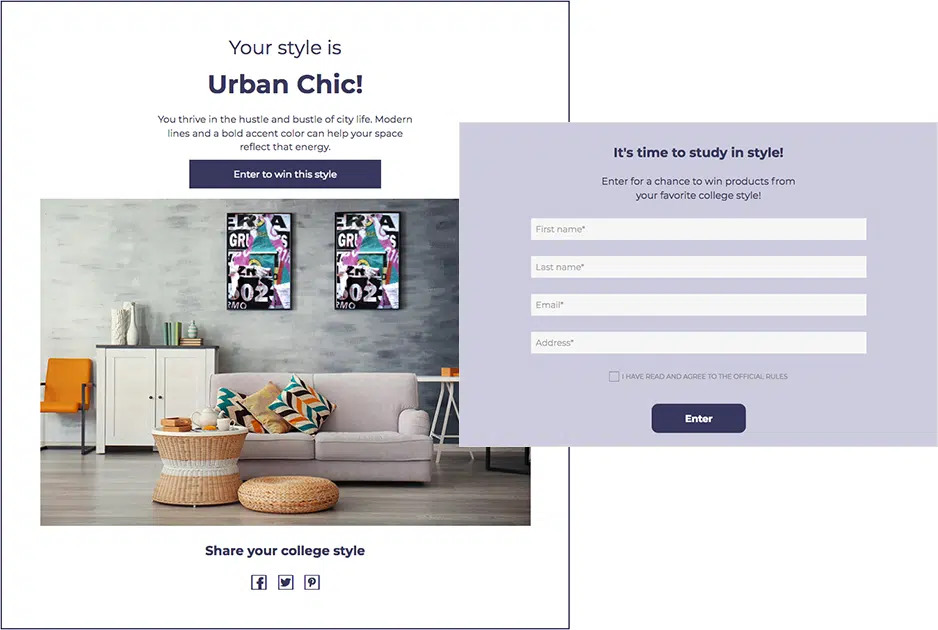
Why it works:
- You don’t have to create any special content. You just need to have the budget to sponsor the prize.
- This is great for the top of the funnel, as the contest itself can drive awareness of your brand. You don’t have to do anything special other than sponsoring a truly attractive prize.
Generally, lead magnets are created in these six steps:
- Find a proven topic. You can find a topic with search potential through keyword research, competitive research, or looking for engaging topics on social media.
- Choose the best content type. The content type will largely depend on the topic. You don’t need to reinvent the wheel here - choose one of the tried and tested examples explained in this article.
- Create your resource. Make sure to check out tools that can help you with that. For example, Teachable will handle all of the technical part of creating an online course, you only need to come up with content.
- Publish your lead magnet. Again, using a dedicated tool will save you a lot of time here. For example, ConvertKit can help you set up sign-up forms on your site and deliver your content. Not all lead magnets need a self-hosted landing page. You can also consider using lead capturing tools on social media (e.g., LinkedIn’s Lead Gen Forms).
- Promote it. Sample ideas: drive organic traffic with relevant blog posts, link from your high-traffic pages, share on your owned media (e.g., email, social media).
- Follow up. Don’t stop at delivering the content. Follow up with the lead with a simple message to establish a conversation or use a sophisticated lead nurturing campaign.
Some of the tools you should find helpful when creating and promoting lead magnets.
- Loom - record your screen for tutorials, how-tos, and other videos.
- Canva - create custom graphics, helpful templates.
- Ahrefs - find topics with search demand, analyze your competition.
- Sparktoro - discover insights about your audience.
- Exploding topics - discover trending topics.
- Unsplash - free stock photography.
- ConvertKit - set up sign-up forms and deliver your resources via email.
- Hubspot - set up sign-up forms, integrate leads in a CRM, send lead nurturing campaigns.
- Teachable - create free (and paid) online courses.
Final thoughts
Lead magnets are a double-edged sword. On the one hand, they can help you get visitors’ contact information. On the other, they can create friction for people who want to access something that could help you sell your products or services.
Are leads more important than getting high volumes of organic traffic and, potentially, more brand awareness? This is a decision you need to make on your own. One solution may be to try and get the best of both worlds by getting your lead magnets search engine optimized.
Want to learn more about lead generation? Check these out:
Got questions or comments? Ping me on Twitter.



